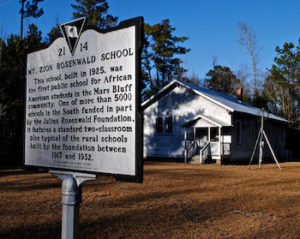
*The Rosenwald School project in America is celebrated in 1917. This Educational endeavor built over 5,000 schools, shops, and teacher homes in the United States primarily to educate Black children in the South during the early 20th century.
The project was the product of the partnership between Julius Rosenwald and Booker T. Washington. The need arose from the chronic underfunding of public education for Black children in the South, as Black people had been discriminated against at the turn of the century and excluded from the political system in that region through Jim Crow Laws. Children were required to attend segregated schools.
Rosenwald and his family established the Rosenwald Fund in 1917 for "the well-being of mankind." Unlike other endowed foundations, which were designed to fund themselves in perpetuity, the Rosenwald Fund was intended to use all its funds for philanthropic purposes. In the segregated schools of the South, African American children were sent to woefully underfunded schools. The collaboration of Rosenwald and Washington led to the construction of almost 5,000 schools for black children in the eleven states of the former Confederacy: Oklahoma, Missouri, Kentucky, and Maryland. As a result of their collaboration, approximately one-third of African American children were educated in these schools.
Rosenwald-Washington collaboration
The Rosenwald-Washington model required African American communities' buy-in and support from white governing bodies. Fulfilling the goals of the match grant program, African American communities contributed $4.8 million to build 5,388 schools, 217 teacher homes, and 163 shop buildings in 883 counties in 15 states, from Maryland to Texas. Research has found that the Rosenwald program accounts for a sizable portion of the educational gains of rural Southern black persons during this period. This research also found significant effects on school attendance, literacy, years of schooling, cognitive test scores, and Northern migration, with gains highest in the most disadvantaged counties. With the program, Black rural communities across the South raised millions of dollars to fund better education for their children, and white school boards had to agree to operate and maintain the schools. Despite this program, by the mid-1930s, white schools in the South were worth more than five times per student than black schools were worth per student (in majority-black Mississippi, this ratio was more than 13 to one).
It donated more than $70 million (equivalent to $754,003,000 in 2020) to public schools, colleges, universities, museums, Jewish charities, and black institutions before the funds were depleted in 1948. The school building program was one of the most extensive programs administered by the Rosenwald Fund, which used state-of-the-art architectural plans designed by professors at the Tuskegee Institute. The fund was based on a matching grant system, requiring white school boards to commit to maintenance and Black communities to aid in construction. In some communities, surviving structures have been preserved because of the deep meaning they had for Blacks as symbols of the dedication of their leaders and communities to education.
Others were threatened by a lack of funds in rural areas, urbanization, demographic changes, changing education styles to consolidated and integrated schools, and other social changes. Former Rosenwald students have led some efforts to preserve Rosenwald Schools. For example, in Georgia, three former Rosenwald Schools were preserved by the efforts of former students and Georgia's Historic Preservation Division, leading to their being listed on the National Register of Historic Places by 2001.
In 2002, the National Trust for Historic Preservation named Rosenwald Schools near the top of the country's most endangered places and created a campaign to raise awareness and money for preservation. At least 60 former Rosenwald Schools are listed on the National Register of Historic Places. In 2015, the National Trust classified the Rosenwald Schools as National Treasures. Several Rosenwald School sites in Georgia have been commemorated through the Georgia Historical Marker Program, currently administered by the Georgia Historical Society. In partnership with community organizations, markers have been erected for the Hiram Rosenwald School (2006, Paulding County), Macon County Training School (2016, Macon County), Barney Colored Elementary School (2013, Brooks County), and Noble Hill Rosenwald School (1995 by the Georgia Department of Natural Resources, Bartow County).
Some schools have been adapted for new uses. Walnut Cove Colored School in Stokes County, North Carolina, won a National Preservation Honor Award for its rehabilitation for use as a senior citizen community center. The Hope Rosenwald School in Pomaria, South Carolina, also will be used as a community center. The school system had continuously used the Highland Park School in Prince George's County, Maryland. It was recently renovated for use as a Head Start Center. The Canetuck Rosenwald School in Currie, North Carolina, has been renovated by the local Black community and is used as a busy community center. The Beauregard Parish Training School in DeRidder, Louisiana, was renovated with a federal grant in 2007 and opened in 2009 as BeauCare Head Start.
Effects
Researchers measured the effects of Rosenwald Schools on rural southern Blacks based on US Census and World War II records and found that the effect on literacy levels and cognitive scores was large. A 2021 study also found that attending Rosenwald schools increased the students' life expectancy and propensity to migrate to the Northern United States.
To Become an Elementary School Teacher
To Become a Middle School Teacher
To become a High School Teacher
To Become a Tech Education Teacher